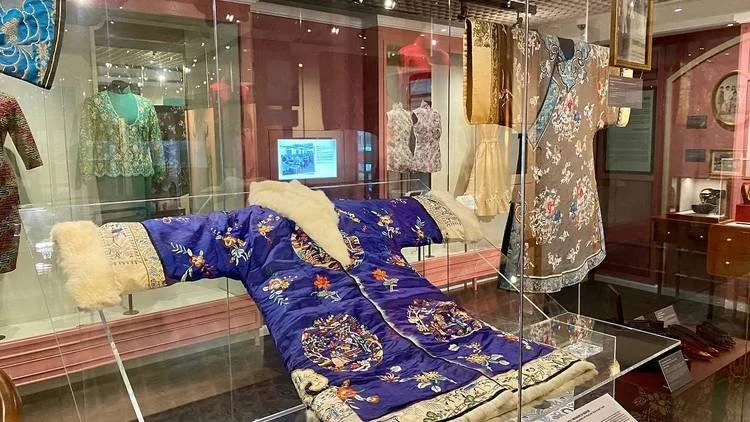Fashion and Change in China and Singapore
‘Modern Women of the Republic’ at Sun Yat Sen Nanyang Memorial Hall
Photograph of Teo Soon Kim (rightmost) with relatives at a port, likely in Singapore, date unknown. Image courtesy of Sun Yat Sen Nanyang Memorial Hall.
The exhibition ‘Modern Women of the Republic: Fashion and Change in China and Singapore’ charts the changes in women’s fashion alongside their shifting roles in society. 93 exhibits curated by Tan Yan Ni from Sun Yat Sen Nanyang Memorial Hall take the audience through a chronological journey from the 1890s to the 1970s. These exhibits, sourced from private collectors, archives, and institutions are arranged thematically to offer an informative visual experience.
One is welcomed into the gallery with a clear vista combining images of ao (blouse) from Singapore Chinese diaspora, robes from China, and 1960s qipaos in the vitrines. This layered view achieves the Memorial Hall’s curatorial premise by linking objects across geographies and time. It also foregrounds the exhibition’s aim of looking at the effects of Sun’s Revolution in Singapore, and the diasporic community’s interconnectedness with the Chinese since the Republican period.
Transitional shoes for feet removed from bindings, Singapore, early Republican period. Image courtesy of Sun Yat Sen Nanyang Memorial Hall.
Following the 1911 Revolution, fashion took a liberating turn. A pair of transitional shoes from the early Republican period marks the abolishment of the practice of feet binding. Placed at the entrance, it effectively sets the tone for the other artefacts on display that likewise broke with tradition to free the body. This is seen in an adjacent section exploring students’ styles following the May Fourth Movement in 1919. Portraits from the 1920s show women in short hair appearing unencumbered compared to the heavily ornamented coiffure a decade ago. A pink wedding costume in the silhouette of ‘Civilised New Outfit’ similarly provided more freedom of movement with shorter hemlines and sleeves. With the help of brief introductory texts about historical moments in China, these exhibits from Singapore show how fashion paralleled political shifts in China.
In a section dedicated to Teo Soon Kim, the first female barrister in Singapore, the curator adopted a biographical approach to showcase her illustrious career, and the photographs and her choice of clothing play a secondary role in helping us understand her life as a trailblazing lawyer and teacher. It is also an apt case study that bridges the connection between Singapore, China, and politics as she was the daughter of Teo Eng Hock, the owner of the villa which houses the Memorial Hall.
Advertisement for ‘Gold Spot’ cigarettes in Lat Pau (叻報), Singapore, 1930. Image courtesy of Sun Yat Sen Nanyang Memorial Hall.
The subsequent zone on media's portrayal of fashion offers visually rich multimedia such as video, pictorials and news advertisements that shed light on how consumer culture influenced fashion. Displaying 2D and digital formats also strategically addresses the space constraint of exhibiting clothes. Building on the collection strength of Singapore magazines in the 1950s and 1960s from National Museum of Singapore, a digital slideshow of news advertisements from a Chinese newspaper, Lat Pau (叻報) covers the 1920s to 1930s. A cigarette advertisement shows a woman in bishop sleeves and knee-length skirt in the silhouette of the Civilised New Outfit. Her relaxed posture beside a suited male reflects the society’s new attitude towards freedom to love. These archives are a fitting point of entry to examine Singapore’s pre-war fashion, as it was the earliest Chinese paper (1881–1932) through which diaspora in Southeast Asia connected to happenings in China. The Chinese daily which also circulated political news is a clever nod to the institution's focus on Dr Sun’s revolution and shows how the curator's diverse sources of research can enrich one's viewing of fashion.
Batik qipao with matching cropped jacket, Singapore, 1960s. Image courtesy of Sun Yat Sen Nanyang Memorial Hall.
Aided by effective exhibition design, one can also perceive the subtle relationships between the garments. A batik qipao from the 1960s tailored with Western-style cropped jacket stands in front of a mirror which reflects the back details of a Republican-period blouse with Art Deco designs. In directing the viewer to look back at fashion’s evolution, the juxtaposition shows Western designs fusing with local traditions. An interview with Chung May Khuen, author of ‘In The Mood for Cheongsam’, attributes a rejection of the restrictive form of the qipao, which remained figure-hugging to the practicality and comfort of ready-to-wear as more women entered the workforce towards the 1970s. The video, located at the end of the circular path of the gallery, calls to mind the same liberation from feet binding that opened the exhibition, thereby reinforcing the ongoing negotiation between women's agency of clothing their body and societal expectations.
View of the gallery. Image courtesy of Sun Yat Sen Nanyang Memorial Hall.
“An inquiry into the decline of various constrictive fashions, from ornamental hairdos to lotus shoes to qipaos, strings together a meaningful and coherent narrative. Fashion’s evolution as shown in this exhibition, mirrors socio-cultural constraints and changes that reflect women’s emancipation in society.”
Despite the modest size of the 92-square-metre gallery and the panoramic timeline, this exhibition assembles comprehensive and multimedia resources in ways that resonate with each other. An inquiry into the decline of various constrictive fashions, from ornamental hairdos to lotus shoes to qipaos, strings together a meaningful and coherent narrative. Fashion’s evolution as shown in this exhibition mirrors socio-cultural constraints and changes that reflect women’s emancipation in society.
‘Modern Women of the Republic: Fashion and Change in China and Singapore’ is on view at Sun Yat Sen Nanyang Memorial Hall through 12 December 2021. As part of the public programme for the exhibition, there is a public lecture by Dr. Loh Kah Seng titled ‘Factory Workers, Modern Women’ on 17 July at 2pm, and a workshop on fashion illustration by Ashley Yeo and Martin Bonney is taking place on 24 July at 2pm. More details here.





